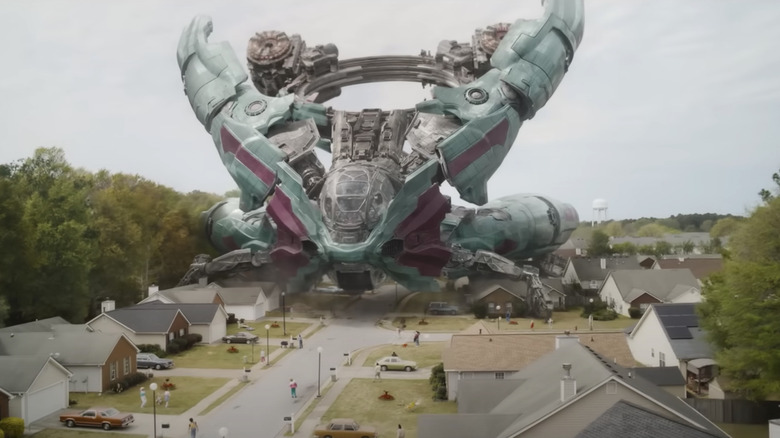Guardians Of The Galaxy 3's New Bowie Ship Design Was Inspired By A Circular Saw
I do not envy any production designer tasked with coming up with a new design for a cinematic spaceship. Ever since we were given the Enterprise and the Millennium Falcon, these designers have been tasked with creating ships that have to accomplish a number of things. They need to make sense as objects that would be shot up into space. They need to be markedly different in design from every other iconic spaceship to come before it. They need to make sure their interior designs are practical for shooting and match the aesthetic of the exterior. And for many, they also need to be appealing to children so those kids will buy them as toys. They also need to appeal to adult toy collectors who will buy a far too expensive model of the ship to prominently display inside its box.
"Guardians of the Galaxy Vol. 3" introduces a new ship for the titular superhero team to cruise around the universe in, and in a nod to all things pop music related in these films, it's called the Bowie. For its toyetic possibilities, I am not the best judge, as I am not someone who collects toys (my collection addictions exist in the physical media realm), but I can say that I found the ship design to be a fairly unique approach in the grand scheme of things. Most importantly, I felt it was a proper cohesive whole and not a collection of different sets built on various soundstages. That cohesiveness and continuity were crucial for production designer Beth Mickle, and to achieve that feeling, they looked to a shape all about continuity: a circle. More specifically, she looked at the design of a circular saw to design the Bowie.
Connected spaces
Circular designs make sense in space. Because you basically cannot leave the ship, having a design where everything connects to everything else is a natural solution to maximizing efficiency floating through the cosmos. Speaking with Nerds & Beyond, production designer Beth Mickle, who started working with James Gunn on "The Suicide Squad," details how circles determined just about everything about the Bowie's design:
"If you look at the shape of the Bowie, you can actually really see it's very circular. Behind the whole pilot deck is circular. That really informed the interior spaces. The med bay where we spend most of the time with Rocket, that's a big circular space, the central core is a big circular space, the spiral staircase ... that really drove a lot of the interior designs. Then you get the nice, iconic shot looking down the long hallways, which are all big and circular in nature. We really took the circular theme and ran with it."
These were not purely aesthetic reasons though. A set can only be great if it is designed in conjunction with how the filmmakers want to shoot the project. Gunn wanted a free-flowing set, and putting it together Mickle "wanted to make sure that all the spaces really connected so that the actors could all go from one space to another to the next in dialogue scenes with long walks, tracking shots, following actors ... same with some of the big fight scenes and choreographed scenes in the ship."
Being able to seamlessly move from one space to another does so much to convey that what you're seeing is real, because it is. There's a believable life to be lived on this fake spaceship, and that's something so few designs are able to capture. The Bowie does.

